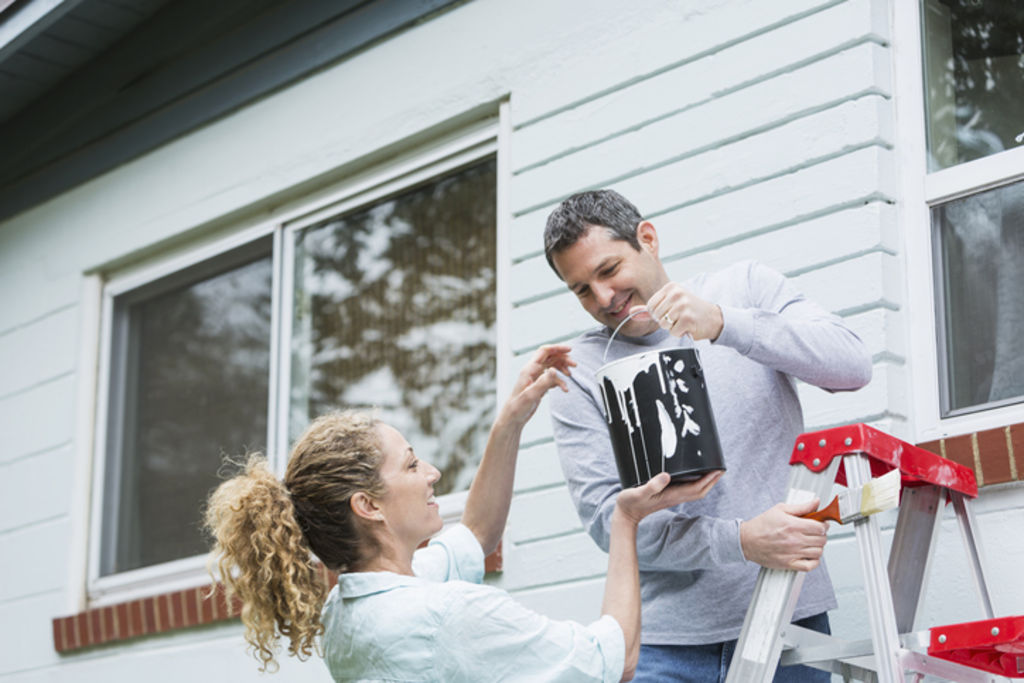DIY renovating jobs you can do while 'working from home'

When I heard that businesses would be encouraging employees to work from home, non-essential gatherings would be cancelled and society was generally sliding into hibernation, I couldn’t help but feel a little bit of positivity among all the uncertainty and worry.
Like many Australians, I’m partway through a renovation of my home, and any chance to put in some extra hours on the house was welcome news.
For me, working from home actually feels more like I’m tapping away on a laptop in the middle of a construction site. Instead of living every writer’s dream of gazing out a window, cup of coffee in hand, watching the world go by while waiting for inspiration, I’m staring at a half-dug stormwater drainage trench, a fence that needs painting and an overgrown jungle of unruly vines.
But while this cluttered vista might depress some people, it’s actually motivated me to get stuck into those projects as soon as possible.
Working on your home while working from home has multiple benefits. Not only will you improve the amenity and value of your property, it will also encourage you to take breaks from being hunched over a computer in less-than-ergonomic conditions, and possibly get you out into the fresh air and sunshine.
Stock up on supplies
Anyone who’s renovated will tell you daily trips to the hardware store are commonplace, and making multiple trips per day is not unheard of. That doesn’t really mesh well with the concept of social isolation, so it’s worth planning your projects, and buying what you need in advance.
To maintain social distancing protocols, it’s a good idea to order online where possible so you don’t need to leave your house at all. Shops such as Bunnings offer delivery as well as click and collect for many items. Just check the returns policy before ordering in case you make a mistake.
Having tools and materials on hand also boost motivation and breaks down barriers to getting the job done. Just remember to only buy what you need and will use.
Paint anything and everything
Believe me, there’s always something in your home you can paint. Whether it’s little touch-ups or a big job you’ve been putting off for years, paint renews a property and makes it feel fresh and modern.
Paint doesn’t just have visual benefits. It also protects exterior timber, metal and masonry surfaces from weathering, reducing the need for regular upkeep.
A period of prolonged downtime over several days is the best time to start a painting project, which is why the Easter long weekend is usually one of the most popular holiday periods for painting. This is because preparation is the key to a good job, and most surfaces require multiple coats and adequate drying time.
In addition to paint, make sure you have brushes, rollers, trays, pails, rags, drop sheets, sandpaper and masking tape. A scraper helps remove flaking paint, and filler seals holes and cracks. A tin of undercoat will help prepare walls in poor condition, or with a very dark existing paint job. Water-based paint is easier to work with for beginners, and easier to clean up.

Colour selection is one of the most challenging parts of painting, and the one that causes the most procrastination among renovators. Here’s a tip: choose a colour scheme recommended by the paint manufacturers – you’ll find a range of swatches in store. It might be the “safe” option, but these colours are chosen to work together and enhance the look of your home. Remember, if you don’t like it, you can always repaint later.
When working on details like door and window frames, trim or skirting boards, it’s a good idea to keep a brush soaking in water so it’s ready to use at all times. That way, if you need a break from working from home, you can get up, do 15 minutes of painting here and there, and get back to work, giving that coat enough time to dry until your next break.
My best tip? Keep a damp rag nearby at all times. It makes cleaning up drips and splashes much easier.
Plant a vegetable garden
Everyone who can should take the opportunity to create a herb or vegetable garden at home. Edible plants are the most rewarding because they grow fast, they’re constantly changing and the end result is delicious, healthy food for you and your family. Plus, plucking a few sprigs of mint straight from the garden is much better than battling other shoppers for the last bunch at the supermarket.
It’s important to consider light levels when choosing what to plant. Most vegetables require a lot of light, while some herbs will happily grow in part-shade. If you’re home all day, you can take note of which areas get full sun, part shade, or full shade. Just check that the description on the plant’s label matches your spot.

Don’t overlook the importance of soil. Healthy soil results in healthy plants, while poor soil will see herbs and vegetables struggle. You can enrich garden beds prior to planting by digging in a bag or two of organic compost with a garden fork. Be sure to cover soil with mulch once the veggies are planted – this prevents moisture loss and weed growth.
If you’re in an apartment, a small home or you’re renting, you can still grow edibles in pots or containers. Opt for a premium potting mix, which is more expensive but has added nutrients and slow-release fertiliser to feed plants. Consider creating a self-watering garden bed for ultimate convenience.
In most parts of the country, the best vegetables to plant now include cabbage, silverbeet, spring onions, lettuce and carrots.
Herbs you can put in now include basil, coriander, rosemary and thyme. Mint is a classic but tends to take over, so separate it from the rest of your patch if possible.
Tackle odd jobs
If you’re feeling productive and looking for quick wins around the home, here are a few simple jobs you can tackle:
Install blinds – Tools you’ll need include a cordless drill and drill bits, tape measure, spirit level and screws, depending on what fasteners comes with the product you purchase.
The surface you’re mounting the blind to will determine the type of drill bits and fasteners you should use. When securing to timber window frames or architraves, use timber screws. When securing to plasterboard walls or ceilings, use plasterboard wall anchors and screws. When securing to masonry, you’ll need a masonry drill bit and potentially a hammer to drill the hole, depending on the hardness of the bricks, as well as masonry wall plugs.
Set up a worm farm – If you’re at home for an extended period of time, you’ll probably be generating more food waste. Instead of putting kitchen scraps into landfill, why not turn it into fertiliser for the garden? Hardware stores both sell worm farm kits and live worms, and it takes less than 30 minutes to have a worm farm ready to use.
Change a door handle – Upgrading outdated door furniture is fairly straightforward when swapping with a similar model. Simply use a screwdriver to remove the screws on the cover plate of the old door handle, remove the knobs and cover plates, slide out the latch mechanism, then install the new handle parts in the reverse order. For older handles and specialist mechanisms such as mortice locks, it’s probably best to engage a locksmith.
We recommend
States
Capital Cities
Capital Cities - Rentals
Popular Areas
Allhomes
More







